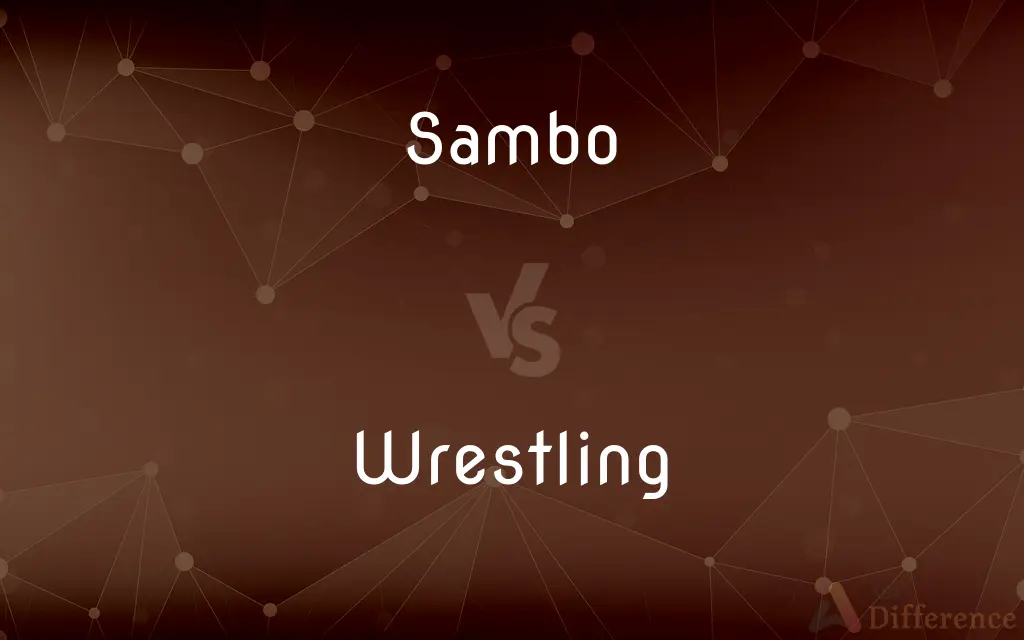Sambo vs. Wrestling — What's the Difference?
Edited by Tayyaba Rehman — By Fiza Rafique — Updated on May 14, 2024
Sambo is a Russian martial art incorporating judo and wrestling techniques, focusing on throws and ground control, whereas wrestling is a global sport with various styles primarily emphasizing grappling and pinning.

Difference Between Sambo and Wrestling
Table of Contents
ADVERTISEMENT
Key Differences
Sambo is a martial art and combat sport developed in the Soviet Union in the early 20th century, integrating judo, wrestling, and other fighting techniques. It is known for its distinctive feature of allowing jacket gripping. Wrestling, on the other hand, is an ancient sport that appears in various forms worldwide, generally focused on taking the opponent to the ground and controlling them, often without the use of a jacket.
Sambo practitioners wear jackets, shorts, and shoes, and compete on a mat similar to those used in judo, allowing for a variety of throws, joint locks, and leg submissions. In contrast, wrestling attire typically consists of a singlet and wrestling shoes, and the sport does not generally allow joint locks or submissions, focusing instead on pins and holds.
The rules of sambo allow for quick transitions between throwing and submission techniques, encouraging dynamic and fast-paced combat. Wrestling rules vary by style (such as freestyle, Greco-Roman, and folkstyle) but generally prioritize control, positioning, and pinning the opponent rather than submissions.
Sambo competitions are categorized into sport sambo, which resembles judo but with some differences in rules and allowed techniques, and combat sambo, which includes striking and more comprehensive self-defense capabilities. Wrestling competitions, however, are divided by style, each with its own set of rules, scoring system, and techniques, reflecting the sport's diverse global heritage.
While both sports are practiced internationally and included in various multi-sport events, wrestling has a longer Olympic history, reflecting its widespread popularity and establishment. Sambo, while recognized worldwide, is still growing in international recognition and is primarily popular in Eastern Europe and former Soviet countries.
ADVERTISEMENT
Comparison Chart
Origin
Soviet Union, early 20th century
Ancient, global
Attire
Jackets, shorts, shoes
Singlet, wrestling shoes
Techniques
Throws, joint locks, submissions
Grappling, pinning, holds
Competition Types
Sport sambo, combat sambo
Freestyle, Greco-Roman, folkstyle
Olympic Status
Not an Olympic sport
An Olympic sport
Compare with Definitions
Sambo
Not currently included in the Olympic Games.
Sambo enthusiasts are advocating for its inclusion in future Olympic events.
Wrestling
An ancient sport focusing on grappling techniques.
Wrestling is one of the oldest forms of combat known to man.
Sambo
Martial art developed in Russia combining judo and wrestling techniques.
Sambo practitioners train to master both throws and submissions.
Wrestling
Includes several styles like freestyle, Greco-Roman, and folkstyle.
He excels in Greco-Roman wrestling, which prohibits holds below the waist.
Sambo
Known for its emphasis on leg locks and ground control.
Sambo's diverse leg locks can quickly end a match.
Wrestling
A staple in the Olympic Games.
Wrestling has been a key sport in the Olympics since the modern games began.
Sambo
Combat sport with two main types: sport and combat sambo.
He competes in combat sambo, which includes punches and kicks.
Wrestling
Aimed at controlling, outmaneuvering, and pinning the opponent.
Wrestling matches often end with one competitor pinning another.
Sambo
Practiced internationally, particularly in Eastern Europe.
Sambo tournaments are especially popular in Russia and surrounding countries.
Wrestling
Practiced worldwide across all age groups.
Kids as young as five start learning wrestling fundamentals.
Sambo
A sandwich.
Wrestling
Wrestling is a combat sport involving grappling-type techniques such as clinch fighting, throws and takedowns, joint locks, pins and other grappling holds. The sport can either be genuinely competitive or sportive entertainment (see professional wrestling).
Sambo
A negro; sometimes, the offspring of a black person and a mulatto; - formerly used colloquially or with humorous intent, but now considered offensive or racist by African-Americans.
Wrestling
A sport in which two competitors attempt to unbalance, control, or immobilize each other by various holds and maneuvers.
Sambo
In Central America, an Indian and negro half-breed, or mixed blood.
Wrestling
Present participle of wrestle
Sambo
A colloquial or humorous appellation for a negro; sometimes, the offspring of a black person and a mulatto; a zambo.
Wrestling
A sport where two opponents attempt to subdue each other in bare-handed grappling using techniques of leverage, holding, and pressure points.
Wrestling
A professional tumbling act that emulates the sport of wrestling. Also called "professional wrestling". It is distinguished from sport wrestling — which has strict internationally recognized rules and is conducted on a mat — by being scripted, rehearsed, conducted in a boxing ring rather than on a mat, and televised as entertainment.
Wrestling
A wrestling match.
Wrestling
(countable) The act of one who wrestles; a struggle to achieve something.
Wrestling
Act of one who wrestles; specif., the sport consisting of the hand-to-hand combat between two unarmed contestants who seek to throw each other.
Wrestling
The act of engaging in close hand-to-hand combat;
They had a fierce wrestle
We watched his grappling and wrestling with the bully
Wrestling
The sport of hand-to-hand struggle between unarmed contestants who try to throw each other down
Common Curiosities
What is the main difference between sambo and wrestling?
Sambo combines judo and wrestling techniques including submissions, whereas wrestling focuses on grappling and pinning without submissions.
Can sambo be used for self-defense?
Yes, particularly combat sambo, which includes self-defense techniques and strikes.
Are there different styles of wrestling?
Yes, there are several styles including freestyle, Greco-Roman, and folkstyle wrestling.
Where did sambo originate?
Sambo was developed in the Soviet Union in the early 20th century.
What are the competitive formats of sambo?
Sambo is divided into sport sambo and combat sambo.
Is wrestling an Olympic sport?
Yes, wrestling has been a part of the Olympics since the modern games began.
What is a pin in wrestling?
A pin involves holding the opponent's shoulders on the mat for a designated period, leading to a win.
How does the scoring system in sambo compare to wrestling?
Sambo scoring rewards throws, submissions, and positional control, while wrestling scores primarily focus on takedowns, reversals, escapes, and pins.
Which sport is older, sambo or wrestling?
Wrestling is older, with historical records dating back thousands of years.
What attire is typical in sambo competitions?
Competitors wear jackets, shorts, and shoes.
How is sambo different from judo?
While both sports use similar jackets and mats, sambo allows more extensive use of leg locks and has different scoring nuances.
What is the global reach of sambo?
Sambo is especially popular in Eastern Europe and former Soviet countries but is growing internationally.
Are there professional leagues for wrestling?
Yes, many countries have professional and amateur wrestling leagues.
Can wrestlers compete in sambo?
Yes, many wrestlers transition to sambo to expand their grappling skills and experience different competition formats.
Does sambo include striking?
Yes, combat sambo includes elements of striking.
Share Your Discovery

Previous Comparison
Highness vs. Majesty
Next Comparison
Emulsion vs. LatexAuthor Spotlight
Written by
Fiza RafiqueFiza Rafique is a skilled content writer at AskDifference.com, where she meticulously refines and enhances written pieces. Drawing from her vast editorial expertise, Fiza ensures clarity, accuracy, and precision in every article. Passionate about language, she continually seeks to elevate the quality of content for readers worldwide.
Edited by
Tayyaba RehmanTayyaba Rehman is a distinguished writer, currently serving as a primary contributor to askdifference.com. As a researcher in semantics and etymology, Tayyaba's passion for the complexity of languages and their distinctions has found a perfect home on the platform. Tayyaba delves into the intricacies of language, distinguishing between commonly confused words and phrases, thereby providing clarity for readers worldwide.
















































